1. 引言
随着风电并网容量的不断增大,风电功率的随机性和波动性给并网区域电网运行的稳定性造成了一定的威胁,其中风电场功率波动引起的无功–电压问题是人们最为关注的问题之一。许多电网运行商也都制定了相应的风电并网技术规定,要求风电场在正常运行条件下能够调节公共并网点的无功功率和电压,平抑由于风速变化带来的电压波动,保证接入点的电压质量。
针对这一问题,诸多学者在该领域进行了广泛而深入的研究,提出了许多不同的控制方法。文献 [1] [2] 分析了DFIG在不同运行方式下对系统电压稳定性的影响,验证了恒电压控制模式在改善系统电压稳定性方面的优越性;文献 [3] 提出静止无功补偿装置(Static Var Compensator, SVC)能够迅速平抑并网点电压的波动,具有快速灵活的无功调节能力;基于以上结论,诸多文献分别从不同角度研究了DFIG与SVC等快速无功补偿装置的协调控制策略。文献 [4] 首先分析了DFIG的无功出力特性,在此基础上提出了SVC与DFIG之间的无功分配策略;文献 [5] [6] 以风电场与电网交换的无功功率为控制目标,综合利用SVC和DFIG的无功调节能力来实现无功优化控制;文献 [7] 建立了综合考虑风电场并网点电压和无功裕度的优化模型,通过协调DFIG和SVC的无功出力达到控制目标;文献 [8] [9] [10] 主要对风电场内部的无功分配原则进行了讨论,根据不同的补偿特性和优化目标,分别提出了不同的控制方法。
上述研究均是基于稳定性的控制目标,讨论无功功率在DFIG与SVC之间的优化分配问题。然而考虑到大型风电场规模较大,集电线路复杂,不合理的无功分配会引起风电场内部有功损耗增加,进而影响风电场的有功出力。因此,优化调节各DFIG与SVC的无功出力,对于降低风电场内部的有功损耗,提高电网运行的稳定性和经济性具有重大的意义。
本文针对风电场出力波动引起的风电场并网点电压波动的问题,首先对风电场出力波动引起风电场并网点电压偏差的机理进行了讨论,对DFIG和SVC的无功调节能力进行了分析,在此基础上,以DFIG与SVC的无功功率为控制对象,建立了DFIG与SVC的无功优化控制模型,形成了DFIG与SVC的优化控制策略。最后,通过实际算例进行了仿真设计,验证了本文所提优化控制策略的有效性。
2. 风电场出力波动对风电场并网点运行电压的影响机理
2.1. 风电场出力波动引起风电场并网点电压偏差的原理
风电场发出的功率经输电线路和变压器注入大电网,忽略送出线路上的充电功率,由于线路和变压器中阻抗的存在,因此输出线路始末两端的电压将出现差值,这是引起电压偏差的根本原因。风电场接入系统等效模型电路图和向量图分别如图1和图2所示。
根据图1风电场接入系统等效模型电路图进行分析,取电网电压 为参考向量,可得
为参考向量,可得
 (1)
(1)
由向量图分析可知,线路上的电压降落可分别由纵分量 和横分量
和横分量 表示,由于一般情况下,
表示,由于一般情况下, 较小,可忽略
较小,可忽略 对电压降落的影响,因此线路的压降
对电压降落的影响,因此线路的压降 可以近似看做横分量
可以近似看做横分量 ,即
,即
 (2)
(2)
由于风电场容量远小于接入系统的容量,可设电压 近似不变,则并网点电压
近似不变,则并网点电压 由风电场注入系统的有功功率
由风电场注入系统的有功功率 、无功功率
、无功功率 决定,当风电场出力波动时,风电场并网点电压便可能产生偏差。
决定,当风电场出力波动时,风电场并网点电压便可能产生偏差。
2.2. 恒电压控制模式下风电场出力波动对并网点电压的影响
当双馈风电机组处于恒电压控制模式时,欲保持并网点电压 恒定,由(2)式可知风电场所需的无功补偿量为
恒定,由(2)式可知风电场所需的无功补偿量为

Figure 1. Equivalent circuit model of wind farm integration
图1. 风电场接入系统等效模型电路图

Figure 2. Equivalent circuit vector diagram of wind farm integration
图2. 风电场接入系统等效电路向量图
 (3)
(3)
假设风电场输出线路阻抗已经确定,则当风电场注入系统的有功功率 发生改变时,风电场维持电压恒定所需的无功功率
发生改变时,风电场维持电压恒定所需的无功功率 就会发生相应的变化。
就会发生相应的变化。
当风电场的无功发生能力不足以维持电压恒定时,风电场并网点电压 就会产生偏差,此时,若要维持电压恒定,只能基于无功缺额限制部分有功出力。
就会产生偏差,此时,若要维持电压恒定,只能基于无功缺额限制部分有功出力。
2.3. 恒功率因数控制模式下风电场出力波动对并网点电压的影响
当双馈风电机组采用恒功率因数控制时,有 ,功率因数限制为±0.98,为减小线路的有功损耗,正常运行情况下通常设定无功功率参考值为0,即近似认为
,功率因数限制为±0.98,为减小线路的有功损耗,正常运行情况下通常设定无功功率参考值为0,即近似认为 ,由(1)式可得
,由(1)式可得
 (4)
(4)
对式(4)进行线性化可得
 (5)
(5)
由式(5)可以看出,当双馈风电场采用恒功率因数控制时,假设风电场输出线路阻抗已经确定,则风电场并网点电压随风电场有功出力的波动而波动。
综上可知,恒电压控制方式由于充分发挥了双馈风电机组的无功调节能力,使得风电场内部的无功优化控制更加灵活有效,在改善系统电压稳定性方面比恒功率因数控制具有更大的优越性。
3. DFIG与SVC的无功调节能力分析
3.1. DFIG的无功功率极限
当以风电场并网点电压为控制目标时,恒功率电压控制的双馈风电机组,可以通过不断地调整风电机组的无功出力来满足电压的要求。双馈风电机组发出的无功能力主要受变流器最大电流和电机容量的限制。
当考虑转子侧电流限制时,其定子侧无功功率极限为 [11]
 (6)
(6)
式中: 、
、 分别为考虑转子侧电流限制时定子侧无功功率最大值和最小值;
分别为考虑转子侧电流限制时定子侧无功功率最大值和最小值; 为定子电压;
为定子电压; 为定子气隙磁场旋转角速度;
为定子气隙磁场旋转角速度; 为定子绕组电感;
为定子绕组电感; 为激磁电感;
为激磁电感; 为转子侧电流器允许最大电流值;
为转子侧电流器允许最大电流值; 为发电机定子侧有功功率。
为发电机定子侧有功功率。
网侧变换器(GSC)无功功率极限为 [12]
 (7)
(7)
式中, 网侧变换器最大视在功率;
网侧变换器最大视在功率; 为发电机转差率。
为发电机转差率。
综上分析,DFIG同时通过发电机定子侧和网侧变换器向电网输出无功功率极限为
 (8)
(8)
式中: 、
、 分别为DFIG可以输出的无功功率上下限。
分别为DFIG可以输出的无功功率上下限。
在不考虑网侧无功输出的情况下,DFIG定子侧的PQ特性曲线近似为以 为圆心的半圆,如图3中虚线所示。考虑到网侧变换器一般按风电机组最大转差率设计,当机组无功出力较小时,网侧变换器无功出力范围较大;当机组处于额定状态时,网侧变换器的无功出力范围较小。因此,当考虑网侧变换器无功出力约束时,双馈风电机组无功功率极限如图3实线所示。
为圆心的半圆,如图3中虚线所示。考虑到网侧变换器一般按风电机组最大转差率设计,当机组无功出力较小时,网侧变换器无功出力范围较大;当机组处于额定状态时,网侧变换器的无功出力范围较小。因此,当考虑网侧变换器无功出力约束时,双馈风电机组无功功率极限如图3实线所示。
3.2.SVC的无功功率极限
为提高风电场快速应对风电出力波动的能力,在风电场并网变电站主变压器低压侧往往装设SVC进行集中无功补偿 [8] ,根据国标规定,对于采用风电汇集站接入电网的风电场,其无功容量为
 (9)
(9)
式中: 、
、 分别为风电场国标规定的容性和感性无功容量;
分别为风电场国标规定的容性和感性无功容量; 、
、 分别为风电场满发时,主变压器和机端变压器消耗的感性无功功率;
分别为风电场满发时,主变压器和机端变压器消耗的感性无功功率; 、
、 分别为风电场满发时送出线路和集电线路消耗的感性无功功率;
分别为风电场满发时送出线路和集电线路消耗的感性无功功率; 为满发时送出线路的充电功率。
为满发时送出线路的充电功率。
由式(6)可知,当 一定时,DFIG的无功容量由输出的有功功率决定,而当机组
一定时,DFIG的无功容量由输出的有功功率决定,而当机组 满发的时候,
满发的时候, ,为确保风电场在任何风速下均能满足国标要求,应在各机组处于满发状态下确定SVC的容量,即
,为确保风电场在任何风速下均能满足国标要求,应在各机组处于满发状态下确定SVC的容量,即
 (10)
(10)
通过以上方法确定的SVC的补偿容量即为SVC的无功功率极限。
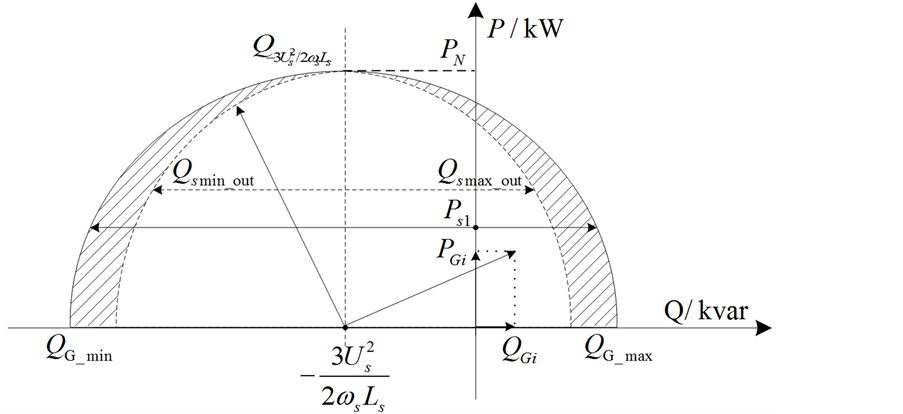
Figure 3. Reactive power limit of doubly fed induction generator
图3. DFIG无功功率极限
4. DFIG与SVC的无功优化控制策略
4.1. DFIG与SVC的无功优化控制思路
对于大型风电场,由于所处地形不同,风电场内部机组排列方式也存在很大差别,其中放射式接线方式具有接线简单,运行方便,经济灵活等优点,在我国风电场中得到了广泛的应用,最典型的放射式风电场结构如图4所示。
正常运行时,DFIG和SVC都会响应上级下达的风电场并网点电压控制指令发出无功功率,对PCC进行无功补偿,既充分发挥了DFIG的无功调节能力,也减小了维持电压恒定所需的SVC无功补偿量;但是另一方面,集电线路上的无功功率流动会产生有功损耗,降低风电场运行的经济性。因此,为了尽可能地减小风电场并网点电压波动,提高风电场运行的经济性,本文提出了基于风电场内部DFIG与SVC的无功优化控制策略,对外响应上级调度控制指令,对内自行优化预设目标。
4.2. DFIG与SVC的无功优化控制模型
(一) 优化目标
1) 风电场电压偏差最小 [13]
风电机组与SVC的无功优化控制是以各DFIG和SVC的无功补偿量为控制对象的,因此,降低各台风电机组端电压和风电场并网点电压偏差,是风电场内部无功优化控制的首要目标。即
 (11)
(11)
式中, 和
和 分别为并网点实际电压和上级调度下达的PCC电压控制指令;
分别为并网点实际电压和上级调度下达的PCC电压控制指令; 和
和 分别为第
分别为第 台DFIG的实际电压和参考电压,这里取
台DFIG的实际电压和参考电压,这里取 ;
; 为风电场DFIG台数。
为风电场DFIG台数。
2) 风电场有功网损最小
考虑到大型风电场规模较大,集电线路复杂,不合理的无功分配会引起风电场内输电线路和集电线路上的有功损耗,为降低风电场有功损耗,提高风电场运行的经济性,引入风电场有功损耗指标如下所示。
 (12)
(12)
式中, 为风电场集电线路的编号,
为风电场集电线路的编号, ;
; 和
和 分别为线路
分别为线路 上和全电场参与无功控制的DFIG数;
上和全电场参与无功控制的DFIG数; 、
、 、
、 和
和 分别为集电线路
分别为集电线路 、送出线路
、送出线路 、机端变压器
、机端变压器 和主变压器
和主变压器 支路的电阻;
支路的电阻; 和
和 分别为线路
分别为线路 和变压器
和变压器 上流过的有功功率;
上流过的有功功率; 和
和 分别为风电机组
分别为风电机组 和SVC的实际无功输出。
和SVC的实际无功输出。
(二) 约束条件
1) 潮流方程约束
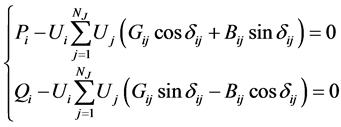 (13)
(13)
式中, 为风电场内部节点数,
为风电场内部节点数, ;
; 、
、 为各节点注入的有功和无功;
为各节点注入的有功和无功; 、
、 为各节点的电压幅值;
为各节点的电压幅值; 、
、 分别为节点
分别为节点 、
、 之间的电导和电纳;
之间的电导和电纳; 为节点
为节点 、
、 之间的电压相角差。
之间的电压相角差。

Figure 4. Structure of radial wind farm
图4. 放射式风电场结构图
2) 控制变量约束
 (14)
(14)
式中, 、
、 分别为由DFIG出力特性决定的无功出力上下限;
分别为由DFIG出力特性决定的无功出力上下限; 、
、 分别为由SVC容量决定的SVC无功出力上下限。
分别为由SVC容量决定的SVC无功出力上下限。
3) 状态变量约束
 (15)
(15)
式中, 代表节点
代表节点 允许的最大电压偏差量。
允许的最大电压偏差量。
(三) DFIG与SVC的多目标无功优化模型
综上,DFIG与SVC的无功优化模型可描述为
 (16)
(16)
式中, 为由优化变量组成的决策变量;
为由优化变量组成的决策变量; 为目标函数;
为目标函数; 为等式约束条件;
为等式约束条件; 为不等式约束条件。
为不等式约束条件。
DFIG与SVC的无功优化问题是一个多目标的优化决策问题,同时使多个目标达到最优是不可能的,因此,通过引入隶属度函数来进行模糊化处理 [14] 。
对于模糊最小化目标函数,各目标的隶属度函数为
 (17)
(17)
 为第
为第 个目标函数值;
个目标函数值; 为第
为第 个目标的理想值;
个目标的理想值; 为决策者可以接受的第
为决策者可以接受的第 个目标的增加量。
个目标的增加量。
由于本文模型的优化目标是在满足所有的约束条件下,尽可能减小风电场并网点电压偏差和风电场内部的有功网损。当 时,表示某个优化结果完全不满足优化目标;当
时,表示某个优化结果完全不满足优化目标;当 时,表示某个优化结果完全满足优化目标。使所有目标的隶属度函数值均等于1是不可能的,必须根据实际情况选出一个最优折衷解,这里引入标准化满意度函数:
时,表示某个优化结果完全满足优化目标。使所有目标的隶属度函数值均等于1是不可能的,必须根据实际情况选出一个最优折衷解,这里引入标准化满意度函数:
 (18)
(18)
这样,原来的多目标非线性优化模型就转变成了没有量纲的单目标非线性优化模型:
 (19)
(19)
式中, 为标准化满意度值;
为标准化满意度值; 为第
为第 个目标函数值;
个目标函数值; 为决策者可以接受的第
为决策者可以接受的第 个目标的增加量。
个目标的增加量。
(四)模型求解
遗传算法(Genetic Algorithm, GA)是一类借鉴生物界自然选择和自然遗传机制的随机搜索算法 [15] 。以生物进化为原型,具有很好的收敛性,计算时间短,鲁棒性高,可以快速地搜索出全局的解而不至于陷入局部最优,在电力系统中得到了很好的开发利用 [16] ,因此本文采用遗传算法对式(19)进一步求解。
4.3. DFIG与SVC的无功优化控制策略
综合以上分析,DFIG与SVC的无功优化控制策略如下:
1) 输入风电场DFIG和PCC运行电压数据和PCC电压控制指令、输入DFIG和SVC无功约束数据;
2) 判断风电场PCC实时电压值是否越限,若是,则报警,不再进行优化计算;若电压没越限,则进行下一步;
3) 根据DFIG有功出力计算其无功可调范围,同时计算当前时刻SVC动态无功补偿量;
4) 以风电场各节点电压偏移量和风电场有功网损最小为优化目标,计算无功优化控制模型,并通过遗传算法进行求解;
5) 判断所求结果是否收敛,且数据是否合理,若收敛且数据合理,则生成优化结果,输出优化控制策略、电压最小偏差及最小网损值。
DFIG与SVC的无功优化控制策略如图5所示。
5. 算例验证
本文以某风电场为例进行仿真分析,如图6所示。该风电场装机容量为60 MW,共有40台1.5 MW的DFIG、40台机端变压器、1台主变压器及1组SVC,其中40台DFIG通过4条地下馈线连接至并网变电站主变压器,风电场馈线信息如表1所示,由于地形不同风电场馈线长度也有所差别。其中,A、B、C、D四条馈线分别连接10台1.5 MW的DFIG,能够参与风电场无功调节,SVC的容量为−10~15 Mvar。
在Matlab/Simulink上搭建上述算例,设置遗传算法的种群规模为40,最大迭代次数为50,选择适当的权重系数构造满意度函数,对风电场并网点电压和风电场内部的有功网损进行优化。
5.1. 优化控制前后并网点电压和无功出力对比分析
为比较DFIG与SVC无功优化控制策略的控制效果,本文分别采用以下4种补偿方案进行仿真。
1) 方案1:本站无功补偿设备不参与补偿,只依靠无穷大系统进行无功补偿;
2) 方案2:只采用风电场升压站的SVC进行无功补偿;
3) 方案3:只采用风电场内部的DFIG进行无功补偿;
4) 方案4:DFIG和SVC均参与无功补偿,且按照本文所提优化控制策略进行无功优化控制。
不同无功补偿方案下风电场并网点电压与风电场有功出力的变化曲线如图7所示。
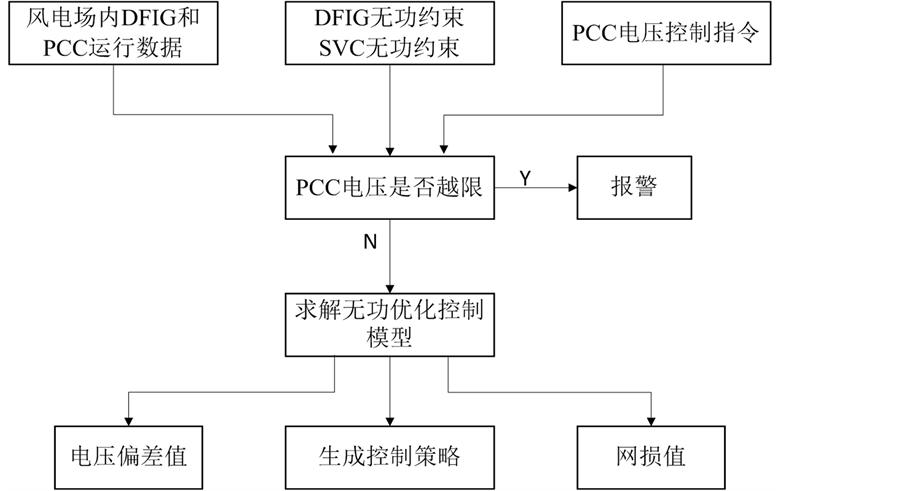
Figure 5. Reactive power optimization control strategy of doubly fed wind turbine and SVC
图5. DFIG与SVC的无功优化控制策略
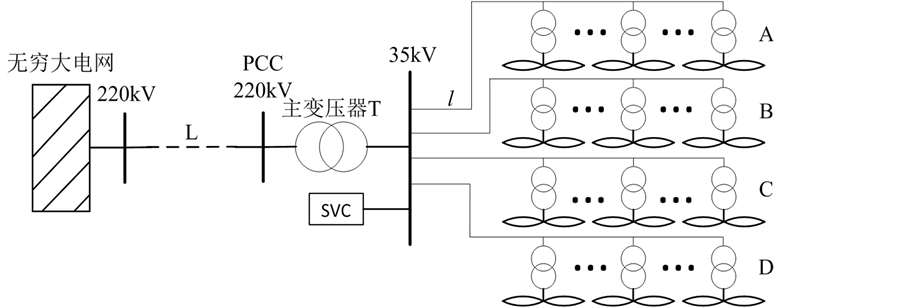
Figure 6. The structure of wind farm simulation system
图6. 标准试验系统结果曲线风电场仿真系统结构图

Table 1. Information of feeder lines of wind farm
表1. 电场馈线信息
从图7中方案2和方案4的电压曲线可以看出,在风电场SVC无功充足的情况下,风电场基本能维持并网点电压恒定,控制效果最佳;从方案3的电压曲线可以看出,当风电场DFIG有功出力较小时,
无功可调范围较大,基本能维持并网点电压恒定,当风电场DFIG无功出力较大时,无功可调范围较小,并网点电压有较大偏差;从方案1的无功电压曲线可以看出,风电场并网点电压偏差始终很大,且与风电场有功出力成正相关。通过以上仿真分析,进一步验证了第2章所提风电出力波动对风电场并网点电压的影响机理。
针对方案2和方案4补偿效果相似,对风电场内部的无功出力进行分析,得到不同控制方式下风电场DFIG和SVC的无功出力曲线如图8所示,为方便分析,有功功率曲线做了等比例缩小。
从图8中可以看出,方案4较方案2的风电场总无功出力更高,这是因为方案4中DFIG也参与了无功补偿,由于DFIG和SVC距离风电场PCC的物理紧密度不同,DFIG经较长的集电线路和变压器送出,会产生一定的无功损耗。通过协调控制DFIG和SVC的无功出力,让DFIG参与无功调节,在增加SVC无功裕度的同时,也降低了因无功流动产生的有功网损。
5.2. 优化控制前后风电场无功出力与有功损耗对比分析
为比较DFIG与SVC无功优化控制策略的降损效果,本文分别采用上述2种补偿方案对风电场内部
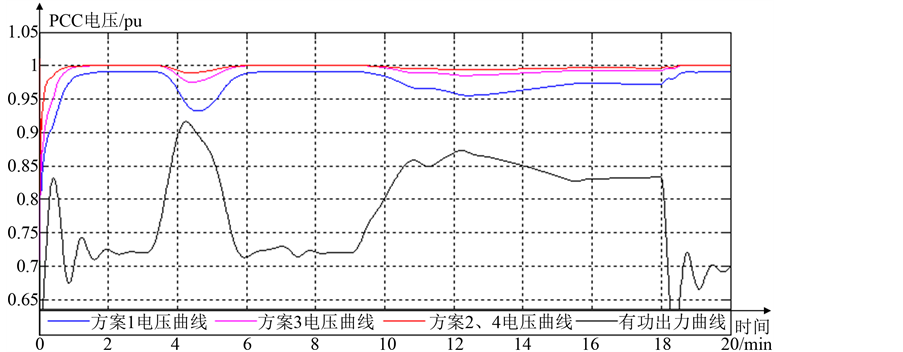
Figure 7. The relationship between the voltage of PCC and the active power output of wind farm
图7. 电场并网点电压与有功出力关系曲线

Figure 8. Reactive power output curves under different control modes
图8. 不同控制方式下风电场无功出力曲线

Table 2. Comparison of reactive power and active power loss under different control strategy
表2. 不同控制方案下风电场无功出力与有功损耗对比
的运行情况进行分析。
1) 方案1:只采用风电场升压站的SVC进行无功补偿;
2) 方案2:采用DFIG和SVC进行无功补偿,且按照本文所提优化控制策略进行无功优化控制。
得到不同控制方式下风电场无功出力与有功网损如表2所示。
表2给出了两种不同补偿方案下的无功分配和有功网损的结果对比,可以看出,本文所提优化控制策略通过协调SVC和DFIG的无功出力,既发挥了DFIG的无功调节能力,又减小了风电场内部的有功网损,提高了风电场运行的经济性。
6. 结论
本文针对风电场出力波动引起风电场并网点电压波动的问题、风电场无功分配不合理引起的风电场内部有功网损增加的问题,建立了DFIG与SVC的无功优化控制模型,并采用遗传算法进行求解,仿真结果表明:
1) 所提无功优化控制策略能够充分发挥DFIG的无功调节能力,实时调整风电场输出的无功功率,提高风电场PCC电压水平。
2) 所提无功优化控制策略通过优化控制DFIG和SVC的无功出力,降低了风电场内部的有功网损,兼顾了风电场运行的经济性。
基金项目
国家自然科学基金面上项目(51377053);国家科技支撑计划(2015BAA01B04);国家电网公司科技项目(522727160002)。